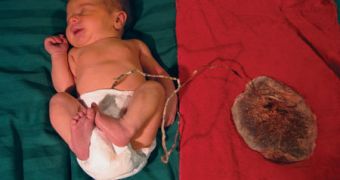A new method of caring for a child shortly after birth seems to be gaining ever more supporters.
The method is known as lotus birth, and refers to the fact that, rather than cutting the umbilical cord immediately after delivery, parents wait for it to detach naturally.
In other words, the kid gets to remain attached to the placenta for up to 10 days, which is how long it takes for it to dry and eventually fall.
In some cases, the process only takes about 3 days.
The supporters of this practice maintain that, contrary to what some might believe, lotus birth is not just a quirky way of making the experience of delivering a child a tad more interesting and special than it already is.
Quite the contrary: it is being said that children who are allowed to get rid of both the placenta and the umbilical cord naturally are likely to be healthier than those whose umbilical cord was severed shortly after birth.
The main argument is that, throughout said 3-10 days, several nutrients that can only be found in the placenta and the umbilical cord get to completely make their way into an infant's body.
The Examiner quotes midwife educator Mary Ceallaigh, who reportedly made a case of how, “[Lotus birth] allows a complete transfer of placental/cord blood into the baby at a time when the baby needs that nourishment the most.”
Those who support umbilical nonseverance also say that, in the case of lotus birth, children are less likely to be affected by infections. This is simply because the umbilical cord has no incisions made in it.
It appears that, while waiting for the umbilical cord and the placenta to naturally detach, parents are left with no choice except wrap them in fabrics and carry them around together with their child.
According to several mothers, the practice is significantly less troublesome than some would suspect, due to the fact that, during these first few days of life, neither the child nor the mother gets to move all that much.

 14 DAY TRIAL //
14 DAY TRIAL //